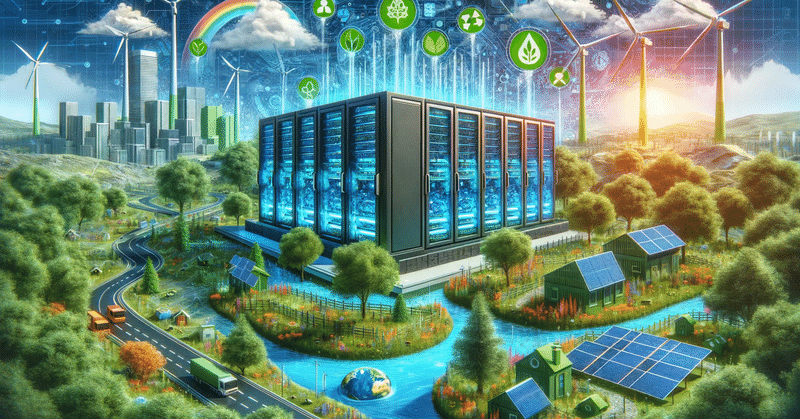
"Bilingual Post" ・AIと環境問題:持続可能な未来を目指して ・AI and Environmental Challenges: Aiming for a Sustainable Future
人工知能(AI)の環境への影響については、まだあまり知られていないが、その実態を伝えるレポートが出てきた。特に、GPT-3は計算過程で発生する熱を防ぐために冷却水が必要である。たとえば、ChatGPTのサーバーは20から50の質問に答えるたびに、500ミリリットルの水を「消費」する。
生成AIツールの人気が高まる中で、これらの技術が環境に与える影響も明らかになってきた。データはまだ少ないが、カリフォルニア大学リバーサイド校とテキサス大学アーリントン校の研究者たちは、OpenAIのGPT-3やGPT-4のウォーターフットプリントに関する研究をまとめている。
マイクロソフトは、データセンターでGPT-3を訓練するのに70万リットルの真水を使用したと報じられている。この量は原子炉の冷却塔を満たすほどであり、BMWの自動車370台またはテスラの自動車320台を作るのに必要な水と同じである。
これらのデータから、ChatGPTが質問に答えるたびに一本のペットボトル分の水を必要とすることが分かる。レポートの筆者は、「一見大した量ではないかもしれないが、全体としては極めて大きなウォーターフットプリントだ」と指摘している。
マイクロソフトは、「AIのエネルギー使用量と炭素影響を測定する研究に投資し、システムのさらなる効率化に取り組んでいる」と述べており、2030年までにカーボンネガティブ、ウォーターポジティブ、廃棄物ゼロを目指している。
GPT-3やGPT-4はデータセンターに保管されており、大量のデータの分析には多くのエネルギーが必要である。適切な温度管理のためには、塩水ではなく真水が使用される。これは塩水が腐食や水道管の詰まり、細菌の増殖を引き起こすためである。新しいGPT-4はモデルサイズが大幅に増加しており、今後水の使用量も増える可能性があると研究者たちは言及している。
エネルギー使用量に加え、水使用効率性も研究されている。AIの訓練にかかる水の消費量については、透明性が欠けており、具体的なフットプリントの特定が困難である。LaMDAの水使用量について尋ねられた際、グーグルはデータセンター全体の水消費量に関するデータを提供した。
研究者たちは、「真に持続可能なAIを実現するためには、カーボンフットプリントとウォーターフットプリントにも取り組む必要がある」と強調している。
The environmental impact of Artificial Intelligence (AI) is not yet well understood, but emerging reports are starting to shed light on this issue. For instance, GPT-3 requires cooling water to mitigate overheating during its computational processes. Notably, every time ChatGPT answers between 20 to 50 questions, its servers "consume" about 500 milliliters of water.
As generative AI tools like ChatGPT become more popular, their environmental impacts are becoming clearer. Although data on AI and sustainability is still scarce, researchers from the University of California, Riverside, and the University of Texas at Arlington have compiled studies on the water footprint of OpenAI's models such as GPT-3 and GPT-4.
It is reported that Microsoft used 700,000 liters of fresh water to train GPT-3 in their data centers. This amount is enough to fill a nuclear reactor's cooling tower and is equivalent to the water used to manufacture 370 BMWs or 320 Teslas.
From these figures, it is clear that ChatGPT requires a bottle's worth of water for every few dozen queries. The report's authors emphasize that "while it may not seem like a lot, the cumulative water footprint is substantial."
Microsoft has stated they are investing in research to measure AI's energy use and carbon impact and are working on further system efficiencies. They aim to be carbon negative, water positive, and achieve zero waste by 2030.
GPT-3 and GPT-4 are housed in data centers, which require significant energy to analyze large datasets. Proper temperature management necessitates the use of fresh water, as salt water can lead to corrosion, clogging, and bacterial growth. The newly released GPT-4 has a significantly larger model size, potentially increasing future water usage, as mentioned by researchers.
In addition to energy consumption, water use efficiency (WUE) is also being studied. The lack of transparency around water consumption in AI training makes it difficult to pinpoint exact footprints. When asked about LaMDA's water usage, Google provided data on the overall water consumption for their data centers.
Researchers emphasize the need for a comprehensive approach to both carbon and water footprints to truly achieve sustainable AI.
#人工知能と環境 #ウォーターフットプリント #持続可能な技術
#AIandEnvironment #WaterFootprint #SustainableTech
この記事が気に入ったらサポートをしてみませんか?
